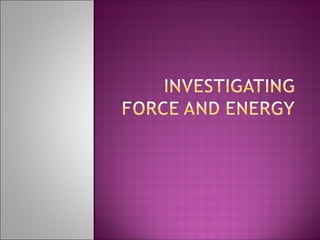
Investigating force and energy
- 2. A force is a push and pull All the daily life activities involve push and pull. Force can not be seen but can be felt.
- 3. 1. Force can change shape of an object. 2. Force can cause a stationary object to move 3. Force can change speed of a moving object. 4. Force can change direction of the moving object.
- 4. Friction is a type of force that opposes the movement of an object. It always acts in the opposite direction to the movement of an object. Friction occurs when two surfaces are contact with each other.
- 5. 1. Produces heat - When we rub our palms together, the palms become warmer because friction produce heat. 2. Opposes motion - When a toy car is given a push, it will move. However, its movement become slower and slower. After sometimes, it will stops. This is due to the friction between its tyres and the floor opposing the motion of the toy car.
- 6. 3. Causes wear and tear - When a pair of shoes is frequently used, the shoes will wear out. The rubbing surfaces between the soles and floor causes the shoes to wear out. Brakes, tyres and engines also wear out after some time due to friction.
- 7. The amount of friction depends on: 1. The types of surfaces - If the surface is rough, it will produce more friction than the smooth surface. 2. The mass of an object - If the mass of an object is bigger, it will produce more friction than the small mass object.
- 8. 1. Using the round and smooth objects like rollers and ball bearings. 2. Using the lubricants like oil, grease and wax. 3. Using air cushion. 4. Using the fine powder.
- 9. Holding things firmer in place Slowing down or stopping moving objects Providing better grip on surfaces Friction can be increased by increasing the roughness of the contact surfaces.
- 10. Enables to hold things in our hand Enables objects to stay in place Produces heat Wears out rubbing surfaces for example between the knife and the stone.
- 11. Friction opposes and slow down the motion, we need to apply force. As the friction produce heat, the heat produced may spoil the engine. Cooling system must be provided to remove the heat. The friction also cause wear and tear. Tyres and break pads in vehicles need to be replaced from time to time.
- 12. Speed is the measurement of how fast an object moves. Object that moves faster has greater speed. Object that moves slower has lower speed.
- 13. Object that moves faster: a) Travel longer distance in a given time b) Takes a shorter time to travel a given distance.
- 14. Calculation of speed is as follow: Speed = distance travelled time taken to calculate speed, we need to know a) The distance travelled by the object b) The time taken to travel the distance
- 15. Sam kicked a ball. The ball moved 9 meters in 3 seconds. What is the speed? Speed of the ball = distance travelled time taken Speed = 9 m 3s = 3m/s
- 16. 1. A bus started its journey from Kuala Lumpur at 8.30 a.m. It reached Tampin, which is 140 km away from Kuala Lumpur, at 10.30 a.m. What is the speed? 2. A ball rolls 8 meters in 2 seconds. What is the speed of the ball? 3. There are two cars. The cars travelled the same distance from Johor Bahru to Kuala Lumpur. The distance is 300 km. Car A, travelled within 3 hours while car B travelled within 4 hours. Calculate the speed of both cars.
